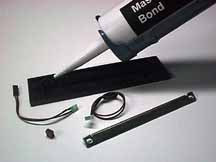 Silicone elastomers offer unique performance characteristics such as serviceability over the remarkably wide temperature range of -150°F to above +500°F, chemical resistance and great stability against weathering. A vast number of silicone elastomer compounds have been developed to meet a wide variety of application requirements in many different types of industries. Some of the more common uses of silicones are as adhesives, sealants, coatings and encapsulants. Silicone elastomers are rather difficult to bond, both to each other and to other substrates.
Silicone elastomers offer unique performance characteristics such as serviceability over the remarkably wide temperature range of -150°F to above +500°F, chemical resistance and great stability against weathering. A vast number of silicone elastomer compounds have been developed to meet a wide variety of application requirements in many different types of industries. Some of the more common uses of silicones are as adhesives, sealants, coatings and encapsulants. Silicone elastomers are rather difficult to bond, both to each other and to other substrates.
There are several groups of commonly used silicone adhesives and sealants. The first and most popular are liquid and paste one component room temperature vulcanizing compounds (RTVs). They are moisture cured and the rate of cure depends upon humidity levels. The second group includes two component liquid and paste compounds which can be cured at ambient temperatures or in some cases, more quickly at elevated temperatures. The third group is pressure sensitive adhesives. The most effective adhesives for bonding silicones are other silicones, specifically certain one part RTVs and specially formulated pressure sensitive silicone compositions. It should be noted that even the best silicone adhesives will provide only moderate bond strengths. There are special circumstances where non-silicone adhesives will adhere to silicone. This is described in more detail below.
When bonding silicone substrates with silicone adhesives, there are several pretreatment options available. The most common pretreatment method is mechanical abrasion and solvent cleaning followed by the use of a primer, such as Master Bond MasterSil 718. Common solvents used for cleaning include acetone and other ketones, alcohols and aromatics such as toluene and xylene. Soap and water washing has also been found to be helpful for enhancing adhesion of certain silicone rubber compounds. Another exciting approach is activated gas plasma etching which enables one to bond silicone with a non-silicone type adhesive such as an epoxy. Plasma treatments consist of high energy, free radical type gas molecules in vacuum that react with and change the nature of the surfaces, albeit temporarily. This surface treatment allows silicones to be bonded by adhesives such as epoxies. The relatively short duration of the altered surface state and the expense of the equipment are the limitations of this approach. However, bond strengths can be very high using plasma treatment and epoxy adhesives. For example, Master Bond EP21ND epoxy system has demonstrated high bond strength (>2,000 psi) in conjunction with plasma treatments.
As mentioned above, the most common approach for bonding silicone substrates is the use of silicone adhesives. Master Bond offers both traditional and newly developed specialty type silicone adhesive compositions. MasterSil 410, 700, 701, 702 and 705 are examples of the more traditional, high performance, one part, room temperature curing, vulcanizing silicone elastomers which are being successfully employed to bond silicone rubbers to themselves and to other substrates. MasterSil 410 and 701 have proven particularly useful because of their ease of application and reliability. Another traditional approach employs pressure sensitive silicone adhesives. These are generally supplied in solvent solutions and are recommended for applications where controlled peel adhesion and easy removability are desired. MasterSil 771 is an example of this type of pressure sensitive system.
Additionally, there are a number of new specialty formulations for bonding silicone substrates. Most notable is MasterSil 711, a super fast, one part, room temperature curing, vulcanizing silicone elastomer compound which provides remarkably fast cures with set up times occurring in as little as 3-5 minutes at ambient temperatures depending on humidity. MasterSil 713 is a unique, low viscosity, one part silicone adhesive/sealant especially well suited for effective sealing and bonding of small gaps. MasterSil 800 and 801 provide unsurpassed thermal stability at temperatures as high as +600°F. They are black in color. A special translucent formulation called MasterSil 803 is available for +500°F service. MasterSil 705TC is a thermally conductive, electrically insulative compound for prolonged usage up to +400°F. It can withstand severe service temperature cycling and has proven ideal for heat sink attachment and other applications where superior heat transfer is required.
